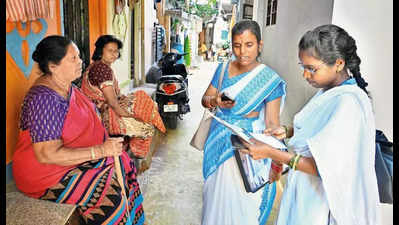Hyderabad: As the Telangana govt prepares to present the socio-economic survey for 2024-25 and the budget for 2025-26, an intriguing debate has emerged: Should the final population figures from the Socio-Economic, Education, Employment, Political and Caste Survey be used to determine the annual projected per capita income (PCI) and gross state domestic product (GSDP) figures?
The question is stirring up discussions and is poised to shape how these key economic indicators are calculated moving forward. Currently, the second round of the survey is underway, with efforts to include individuals who were previously omitted.
Govt sources suggest that there is growing consideration that the final population data from this survey could serve as the basis for calculating PCI, rather than relying on the 2011 Census figures. This proposal has led to questions about how the state’s economic measurements should evolve, considering the demographic shifts observed in the state.
Under current regulations, the 2011 Census data is the only official demographic source, and it must be used as the baseline for calculating both PCI and GSDP. This data is critical because the central govt mandates its use in national and state-level economic reporting. Any demographic surveys conducted by state govts, including the socio-economic surveys, are categorised as private censuses, with no official recognition or legal weight. Although these surveys can provide valuable insights into population trends, they do not hold the same standing as the official Census, senior experts in the field explained.
Telangana’s socio-economic survey stands out due to its scale—being one of the largest and first-of-its-kind in India, along with similar efforts in Karnataka and Bihar. This survey has sparked new debates on whether it could replace the outdated 2011 Census figures in determining key economic indicators.
Since 2011, the Centre has not conducted any significant demographic exercise, and projections for population growth in 2031 are only available as estimates. The Union ministry of statistics and programme iImplementation conducts household surveys on various economic parameters like labor participation, but these surveys cover limited samples.
GSDP and GDP calculations are essential measures of economic health, representing the total value of goods and services produced within a state or country in a given year (for example, cars, food, furniture, etc). PCI, a key indicator of citizens’ economic well-being, is derived by dividing the total GSDP by the population figures. The ongoing debate centers on whether using the 2011 Census data or the socio-economic survey results will provide a more accurate representation of Telangana’s current economic landscape.
The topic gained further attention when AIMIM floor leader Asaduddin Owaisi raised the question during discussions in the state assembly. However, govt sources have clarified that while permission from the Centre isn’t necessary to use socio-economic survey figures, the current rules require Census data. “A policy decision will ultimately determine how PCI and GSDP will be calculated after the completion of the second round of the socio-economic survey,” a source said.
As the state navigates this complex issue, the outcome could have significant implications for how economic indicators reflect the evolving demographic and economic realities of Telangana, an economic expert pointed out.








